The Impact of the COVID-19 Pandemic on the Composition of Dietary Supplements and Functional Foods Notified in Poland
Abstract
:1. Introduction
2. Materials and Methods
3. Results
3.1. Ingredients of Special Importance in the Register
3.2. Average Number of Ingredients per Product
3.3. Activity of Registering Entities
3.4. Proportion of Ingredients in Products in the Period before and after the Announcement of the Pandemic and Their Popularity on the Internet
3.4.1. Vitamin C and Zinc
3.4.2. Vitamin D
3.4.3. Selenium
3.4.4. Potassium
3.4.5. Iron
3.4.6. Vitamin B6, Folic Acid
3.4.7. Pantothenic Acid
3.4.8. Magnesium, Calcium
3.4.9. Biotin, Vitamin E, Vitamin B12, Niacin
4. Discussion
5. Conclusions
Author Contributions
Funding
Data Availability Statement
Conflicts of Interest
Appendix A
| Ingredient | Before Pandemic | During Pandemic | p Value | ||||
|---|---|---|---|---|---|---|---|
| Median | Q1 | Q3 | Median | Q1 | Q3 | ||
| Vitamin C | 0.36 | 0.21 | 0.50 | 0.69 | 0.62 | 0.75 | <0.001 |
| Zinc | 0.25 | 0.12 | 0.42 | 0.60 | 0.55 | 0.67 | <0.001 |
| Vitamin D | 0.27 | 0.14 | 0.41 | 0.62 | 0.54 | 0.69 | <0.001 |
| Selenium | 0.21 | 0.08 | 0.40 | 0.57 | 0.48 | 0.64 | <0.001 |
| Potassium | 0.04 | 0.02 | 0.07 | 0.59 | 0.53 | 0.67 | <0.001 |
| Iron | 0.21 | 0.06 | 0.38 | 0.57 | 0.50 | 0.64 | <0.001 |
| Vitamin B6 | 0.32 | 0.20 | 0.48 | 0.65 | 0.56 | 0.69 | <0.001 |
| Folic acid | 0.25 | 0.11 | 0.40 | 0.60 | 0.54 | 0.66 | <0.001 |
| Pantothenic acid | 0.26 | 0.10 | 0.40 | 0.62 | 0.53 | 0.66 | <0.001 |
| Magnesium | 0.26 | 0.13 | 0.43 | 0.60 | 0.53 | 0.66 | <0.001 |
| Biotin | 0.26 | 0.10 | 0.41 | 0.61 | 0.53 | 0.66 | <0.001 |
| Calcium | 0.22 | 0.10 | 0.39 | 0.58 | 0.49 | 0.65 | <0.001 |
| Vitamin E | 0.26 | 0.13 | 0.42 | 0.60 | 0.54 | 0.66 | <0.001 |
| Vitamin B12 | 0.29 | 0.15 | 0.43 | 0.60 | 0.55 | 0.66 | <0.001 |
| Niacin | 0.29 | 0.13 | 0.43 | 0.62 | 0.53 | 0.67 | <0.001 |
Appendix B
| RSV | Before Pandemic | During Pandemic | p Value | ||||
|---|---|---|---|---|---|---|---|
| Median | Q1 | Q3 | Median | Q1 | Q3 | ||
| Vitamin C | 26.00 | 21.00 | 31.00 | 27.00 | 24.00 | 34.00 | 0.052 |
| Zinc | 15.00 | 14.00 | 18.00 | 22.50 | 17.00 | 28.00 | <0.001 |
| Vitamin D | 25.00 | 18.00 | 30.00 | 29.50 | 21.00 | 37.00 | 0.016 |
| Selenium | 42.50 | 36.00 | 52.00 | 52.50 | 43.00 | 63.00 | <0.001 |
| Potassium | 55.00 | 49.00 | 61.00 | 56.00 | 50.00 | 64.00 | 0.253 |
| Iron | 56.00 | 48.00 | 61.00 | 66.50 | 58.00 | 75.00 | <0.001 |
| Vitamin B6 | 45.50 | 31.00 | 57.00 | 37.00 | 30.00 | 50.00 | 0.088 |
| Folic acid | 62.50 | 54.00 | 72.00 | 55.00 | 49.00 | 61.00 | 0.001 |
| Pantothenic acid | 15.00 | 0.00 | 30.00 | 26.50 | 12.00 | 39.00 | 0.203 |
| Magnesium | 68.00 | 60.00 | 73.00 | 69.50 | 62.00 | 80.00 | 0.220 |
| Biotin | 56.50 | 45.00 | 73.00 | 55.00 | 46.00 | 67.00 | 0.818 |
| Calcium | 49.50 | 35.00 | 61.00 | 53.00 | 38.00 | 64.00 | 0.333 |
| Vitamin E | 59.00 | 48.00 | 69.00 | 54.00 | 41.00 | 65.00 | 0.117 |
| Vitamin B12 | 50.00 | 41.00 | 61.00 | 50.50 | 40.00 | 60.00 | 0.978 |
| Niacin | 39.50 | 27.00 | 57.00 | 46.00 | 25.00 | 54.00 | 0.698 |
Appendix C
| Ingredient | Valid N | R Spearman | p Value |
|---|---|---|---|
| Vitamin C | 54 | 0.29 | 0.033 |
| Zinc | 54 | 0.29 | 0.031 |
| Vitamin D | 54 | 0.58 | <0.001 |
| Selenium | 54 | 0.31 | 0.025 |
| Potassium | 54 | 0.29 | 0.032 |
| Iron | 54 | 0.50 | <0.001 |
| Vitamin B6 | 54 | 0.07 | 0.604 |
| Folic acid | 54 | 0.35 | 0.010 |
| Pantothenic acid | 54 | 0.20 | 0.144 |
| Magnesium | 54 | 0.75 | <0.001 |
| Biotin | 54 | 0.12 | 0.376 |
| Calcium | 54 | 0.34 | 0.012 |
| Vitamin E | 54 | 0.15 | 0.274 |
| Vitamin B12 | 54 | 0.29 | 0.035 |
| Niacin | 54 | 0.37 | 0.006 |
Appendix D
| Ingredient/Health-Promoting Action | Immune System | Protection from Oxidative Stress | Beauty (Hair, Skin, Nails) | Reproductive Functions | Energy Metabolism | Nervous System | Psychological/Cognitive Functions | Preventing Tiredness and Fatigue | Bones and Teeth | Muscles | Cell Division | Blood and Circulatory System | Hormones | Mucous Membranes | Support of Ingestion of Vitamins and Other Nutrients | DNA Protection and Protein Synthesis | Acid-Base Balance | Vision Improvement |
|---|---|---|---|---|---|---|---|---|---|---|---|---|---|---|---|---|---|---|
| Vitamin C | • | • | • | • | • | • | • | • | • | • | • | |||||||
| Zinc | • | • | • | • | • | • | • | • | • | • | • | • | • | |||||
| Vitamin D | • | • | • | • | • | |||||||||||||
| Selenium | • | • | • | • | • | |||||||||||||
| Potassium | • | • | • | |||||||||||||||
| Iron | • | • | • | • | • | • | ||||||||||||
| Vitamin B6 | • | • | • | • | • | • | • | |||||||||||
| Folic acid | • | • | • | • | • | • | • | • | ||||||||||
| Pantothenic acid | • | • | • | • | • | |||||||||||||
| Magnesium | • | • | • | • | • | • | • | • | • | |||||||||
| Calcium | • | • | • | • | • | • | ||||||||||||
| Biotin | • | • | • | • | • | • | ||||||||||||
| Vitamin E | • | |||||||||||||||||
| Vitamin B12 | • | • | • | • | • | • | • | |||||||||||
| Niacin | • | • | • | • | • |
References
- The Act of 11 May 2001 on Sanitary Conditions of Food and Nutrition (Journal of Laws No. 63, Item 634). Available online: https://sip.lex.pl/#/act/16901910/170373 (accessed on 13 July 2021).
- The Act of 25 August 2006 on Food and Nutrition Safety (Journal of Laws No. 171, Item 1225). Available online: https://sip.lex.pl/#/act/17302608/645266?keyword=bezpiecze%C5%84stwo%20%C5%BCywno%C5%9Bci&cm=SFIRST (accessed on 13 July 2021).
- The Act of 25 August 2006 on Food and Nutrition Safety (Journal of Laws of 2020 Item 2021 as Amended). Available online: https://sip.lex.pl/#/act/17302608/2844294/bezpieczenstwo-zywnosci-i-zywienia?keyword=bezpiecze%C5%84stwo%20%C5%BCywno%C5%9Bci&cm=SFIRST (accessed on 13 July 2021).
- Jung, S.; Kinoshita, R.; Thompson, R.N.; Linton, N.M.; Yang, Y.; Akhmetzhanov, A.R.; Nishiura, H. Epidemiological Identification of A Novel Pathogen in Real Time: Analysis of the Atypical Pneumonia Outbreak in Wuhan, China, 2019–2020. J. Clin. Med. 2020, 9, 637. [Google Scholar] [CrossRef] [PubMed] [Green Version]
- Gujski, M.; Raciborski, F.; Jankowski, M.; Nowicka, P.M.; Rakocy, K.; Pinkas, J. Epidemiological Analysis of the First 1389 Cases of COVID-19 in Poland: A Preliminary Report. Med. Sci. Monit. 2020, 26, 26. [Google Scholar] [CrossRef] [PubMed]
- Dmuchowska, D.A.; Pieklarz, B.; Konopinska, J.; Mariak, Z.; Obuchowska, I. Impact of Three Waves of the COVID-19 Pandemic on the Rate of Elective Cataract Surgeries at a Tertiary Referral Center: A Polish Perspective. Int. J. Environ. Res. Public Health 2021, 18, 8608. [Google Scholar] [CrossRef] [PubMed]
- Boguszewski, R.; Makowska, M.; Podkowińska, M. A Typology of Poles’ Attitudes toward COVID-19 during the First Wave of the Pandemic. Int. J. Environ. Res. Public Health 2021, 18, 2002. [Google Scholar] [CrossRef]
- Kontis, V.; Bennett, J.E.; Rashid, T.; Parks, R.M.; Pearson-Stuttard, J.; Guillot, M.; Asaria, P.; Zhou, B.; Battaglini, M.; Corsetti, G.; et al. Magnitude, Demographics and Dynamics of the Effect of the First Wave of the COVID-19 Pandemic on All-Cause Mortality in 21 Industrialized Countries. Nat. Med. 2020, 26, 1919–1928. [Google Scholar] [CrossRef]
- Samy, M.; Abdelmalak, R.; Ahmed, A.; Kelada, M. Social Media as a Source of Medical Information during COVID-19. Med. Educ. Online 2020, 25, 1791467. [Google Scholar] [CrossRef]
- Babicki, M.; Szewczykowska, I.; Mastalerz-Migas, A. Mental Health in the Era of the Second Wave of SARS-CoV-2: A Cross-Sectional Study Based on an Online Survey among Online Respondents in Poland. Int. J. Environ. Res. Public Health 2021, 18, 2522. [Google Scholar] [CrossRef]
- National Health Fund. Available online: https://www.nfz.gov.pl/aktualnosci/aktualnosci-centrali/teleporady-w-ambulatoryjnej-opiece-specjalistycznej,7627.html (accessed on 20 June 2021).
- Opinc, A.; Łukasik, Z.; Makowska, J. The Attitude of Polish Rheumatology Patients towards Telemedicine in the Age of the COVID-19 Pandemic. Reumatologia/Rheumatology 2020, 58, 134–141. [Google Scholar] [CrossRef]
- Maluchnik, M.; Podwójcic, K.; Więckowska, B. Decreasing Access to Cancer Diagnosis and Treatment during the COVID-19 Pandemic in Poland. Acta Oncol. 2021, 60, 28–31. [Google Scholar] [CrossRef]
- Karbownik, M.S.; Dobielska, M.; Paul, E.; Kowalczyk, R.P.; Kowalczyk, E. Health-, Medication- and Dietary Supplement-Related Behaviors and Beliefs Relatively Unchanged during the COVID-19 Pandemic Lockdown. Res. Soc. Adm. Pharm. 2021, 17, 1501–1506. [Google Scholar] [CrossRef]
- Lordan, R.; Rando, H.M.; COVID-19 Review Consortium; Bansal, V.; Barton, J.P.; Boca, S.M.; Brueffer, C.; Byrd, J.B.; Capone, S.; Das, S.; et al. Dietary Supplements and Nutraceuticals under Investigation for COVID-19 Prevention and Treatment. mSystems 2021, 6, e00122-21. [Google Scholar] [CrossRef]
- Barnes, K.; Ball, L.; Desbrow, B.; Alsharairi, N.; Ahmed, F. Consumption and Reasons for Use of Dietary Supplements in an Australian University Population. Nutrition 2016, 32, 524–530. [Google Scholar] [CrossRef]
- Mossink, J.P. Zinc as Nutritional Intervention and Prevention Measure for COVID–19 Disease. BMJ Nutr. Prev. Health 2020, 3, 111–117. [Google Scholar] [CrossRef]
- Moghaddam, A.; Heller, R.; Sun, Q.; Seelig, J.; Cherkezov, A.; Seibert, L.; Hackler, J.; Seemann, P.; Diegmann, J.; Pilz, M.; et al. Selenium Deficiency Is Associated with Mortality Risk from COVID-19. Nutrients 2020, 12, 2098. [Google Scholar] [CrossRef]
- Stachowska, E.; Folwarski, M.; Jamioł-Milc, D.; Maciejewska, D.; Skonieczna-Żydecka, K. Nutritional Support in Coronavirus 2019 Disease. Medicina 2020, 56, 289. [Google Scholar] [CrossRef]
- Hamulka, J.; Jeruszka-Bielak, M.; Górnicka, M.; Drywień, M.E.; Zielinska-Pukos, M.A. Dietary Supplements during COVID-19 Outbreak. Results of Google Trends Analysis Supported by PLifeCOVID-19 Online Studies. Nutrients 2020, 13, 54. [Google Scholar] [CrossRef]
- Adams, K.K.; Baker, W.L.; Sobieraj, D.M. Myth Busters: Dietary Supplements and COVID-19. Ann. Pharmacother. 2020, 54, 820–826. [Google Scholar] [CrossRef]
- Plümper, T.; Neumayer, E. Lockdown Policies and the Dynamics of the First Wave of the Sars-CoV-2 Pandemic in Europe. J. Eur. Public Policy 2020, 1–21. [Google Scholar] [CrossRef]
- Pokryszko-Dragan, A.; Marschollek, K.; Nowakowska-Kotas, M.; Aitken, G. What Can We Learn from the Online Learning Experiences of Medical Students in Poland during the SARS-CoV-2 Pandemic? BMC Med. Educ. 2021, 21, 450. [Google Scholar] [CrossRef]
- Skotnicka, M.; Karwowska, K.; Kłobukowski, F.; Wasilewska, E.; Małgorzewicz, S. Dietary Habits before and during the COVID-19 Epidemic in Selected European Countries. Nutrients 2021, 13, 1690. [Google Scholar] [CrossRef]
- Google Trends. Available online: https://trends.google.pl/trends/?geo=PL (accessed on 19 April 2021).
- Data Concerning COVID-19 Infections Ministry of Health. Available online: https://www.gov.pl/web/koronawirus/wykaz-zarazen-koronawirusem-sars-cov-2 (accessed on 16 June 2021).
- Regulation (EU) No. 1924/2006 of the European Parliament and council of 20 December 2006 on Nutrition and Health Claims Made on Foods. Available online: http://data.europa.eu/eli/reg/2006/1924/2014-12-13 (accessed on 16 June 2021).
- Regulation (EU) No. 432/2012 of 16 May 2012 Establishing a List of Permitted Health Claims Made on Foods Other than Those Referring to the Reduction of Disease Risk and to Children’s DEVELOPMENT and health. Available online: http://data.europa.eu/eli/reg/2012/432/2017-08-22 (accessed on 16 June 2021).
- WHO Conference. Available online: https://www.who.int/director-general/speeches/detail/who-director-general-s-opening-remarks-at-the-media-briefing-on-covid-19---11-march-2020 (accessed on 13 July 2021).
- Sigłowa, A.; Bertrandt, B.; Conder, M.; Bertrandt, K.; Lisiecka, A.; Kubiak, P.; Urbańska, A. Suplementacja diety wśród studentów (Dietary supplementation among college students). Żywn Nauka Technol Jakość 2009, 4, 236–249. [Google Scholar]
- Schlegel-Zawadzka, G.; Barteczko, M. Ocena stosowania suplementów diety pochodzenia naturalnego w celach prozdrowotnych przez osoby dorosłe. (Evaluation of the Natural Supplements Usage by Adults for Wholesome Purposes). Żywn Nauka Technol Jakość 2009, 4, 375–387. [Google Scholar]
- Bieżanowska-Kopeć, R.; Leszczyńska, T.; Kopeć, A. Suplementacja diety studentów wyższych uczelni województwa małopolskiego witaminami i/lub składnikami mineralnymi. (Dietary supplementation with vitamins and/or minerals among students at higher education institutions in the Malopolska province.). Żywn Nauka Technol Jakość 2010, 4, 132–140. [Google Scholar]
- Reguła, J.; Gramza-Michałowska, A.; Stachowiak, B. Participation of dietary supplements in adult nutrition. Probl. Hig. Epidemiol. 2011, 3, 614–616. [Google Scholar]
- Krejpcio, Z.; Skwarek, K.; Hyżyk, A.K.; Dyba, S. Evaluation of prevalence of dietary supplements intake in a selected group of sports people. Probl. Hig. Epidemiol. 2011, 92, 935–938. [Google Scholar]
- Dorożyński, J. Opinions and Experiences of Consumers of Dietary Supplements Expressed in a Questionnaire Survey, with Special Emphasis on Adverse Effects; Uniwersytet Medyczny: Łódź, Poland, 2019. [Google Scholar]
- Karbownik, M.S.; Paul, E.; Nowicka, M.; Nowicka, Z.; Kowalczyk, R.P.; Kowalczyk, E.; Pietras, T. Knowledge about Dietary Supplements and Trust in Advertising Them: Development and Validation of the Questionnaires and Preliminary Results of the Association between the Constructs. PLoS ONE 2019, 14, e0218398. [Google Scholar] [CrossRef]
- Bertrand, L.; Shaw, K.A.; Ko, J.; Deprez, D.; Chilibeck, P.D.; Zello, G.A. The Impact of the Coronavirus Disease 2019 (COVID-19) Pandemic on University Students’ Dietary Intake, Physical Activity, and Sedentary Behaviour. Appl. Physiol. Nutr. Metab. 2021, 46, 265–272. [Google Scholar] [CrossRef]
- Cicero, A.; Fogacci, F.; Giovannini, M.; Mezzadri, M.; Grandi, E.; Borghi, C.; the Brisighella Heart Study Group. COVID-19-Related Quarantine Effect on Dietary Habits in a Northern Italian Rural Population: Data from the Brisighella Heart Study. Nutrients 2021, 13, 309. [Google Scholar] [CrossRef]
- Alexander, J.; Tinkov, A.; Strand, T.A.; Alehagen, U.; Skalny, A.; Aaseth, J. Early Nutritional Interventions with Zinc, Selenium and Vitamin D for Raising Anti-Viral Resistance Against Progressive COVID-19. Nutrients 2020, 12, 2358. [Google Scholar] [CrossRef]
- Bae, M.; Kim, H. The Role of Vitamin C, Vitamin D, and Selenium in Immune System against COVID-19. Molecules 2020, 25, 5346. [Google Scholar] [CrossRef]
- Pikoos, T.D.; Buzwell, S.; Sharp, G.; Rossell, S.L. The COVID-19 Pandemic: Psychological and Behavioral Responses to the Shutdown of the Beauty Industry. Int. J. Eat. Disord. 2020, 53, 1993–2002. [Google Scholar] [CrossRef] [PubMed]
- Shakoor, H.; Feehan, J.; Al Dhaheri, A.S.; Ali, H.I.; Platat, C.; Ismail, L.C.; Apostolopoulos, V.; Stojanovska, L. Immune-Boosting Role of Vitamins D, C, E, Zinc, Selenium and Omega-3 Fatty Acids: Could They Help against COVID-19? Maturitas 2021, 143, 1–9. [Google Scholar] [CrossRef] [PubMed]
- Kumrungsee, T.; Zhang, P.; Chartkul, M.; Yanaka, N.; Kato, N. Potential Role of Vitamin B6 in Ameliorating the Severity of COVID-19 and Its Complications. Front. Nutr. 2020, 7, 562051. [Google Scholar] [CrossRef] [PubMed]
- Noori, M.; Nejadghaderi, S.A.; Sullman, M.J.M.; Carson-Chahhoud, K.; Kolahi, A.; Safiri, S. Epidemiology, Prognosis and Management of Potassium Disorders in Covid-19. Rev. Med. Virol. 2021, e2262. [Google Scholar] [CrossRef]
- The Modena Covid-19 Working Group (MoCo19); Alfano, G.; Ferrari, A.; Fontana, F.; Perrone, R.; Mori, G.; Ascione, E.; Magistroni, R.; Venturi, G.; Pederzoli, S.; et al. Hypokalemia in Patients with COVID-19. Clin. Exp. Nephrol. 2021, 25, 401–409. [Google Scholar] [CrossRef]
- Duan, H.; Yan, L.; Ding, X.; Gan, Y.; Kohn, N.; Wu, J. Impact of the COVID-19 Pandemic on Mental Health in the General Chinese Population: Changes, Predictors and Psychosocial Correlates. Psychiatry Res. 2020, 293, 113396. [Google Scholar] [CrossRef]


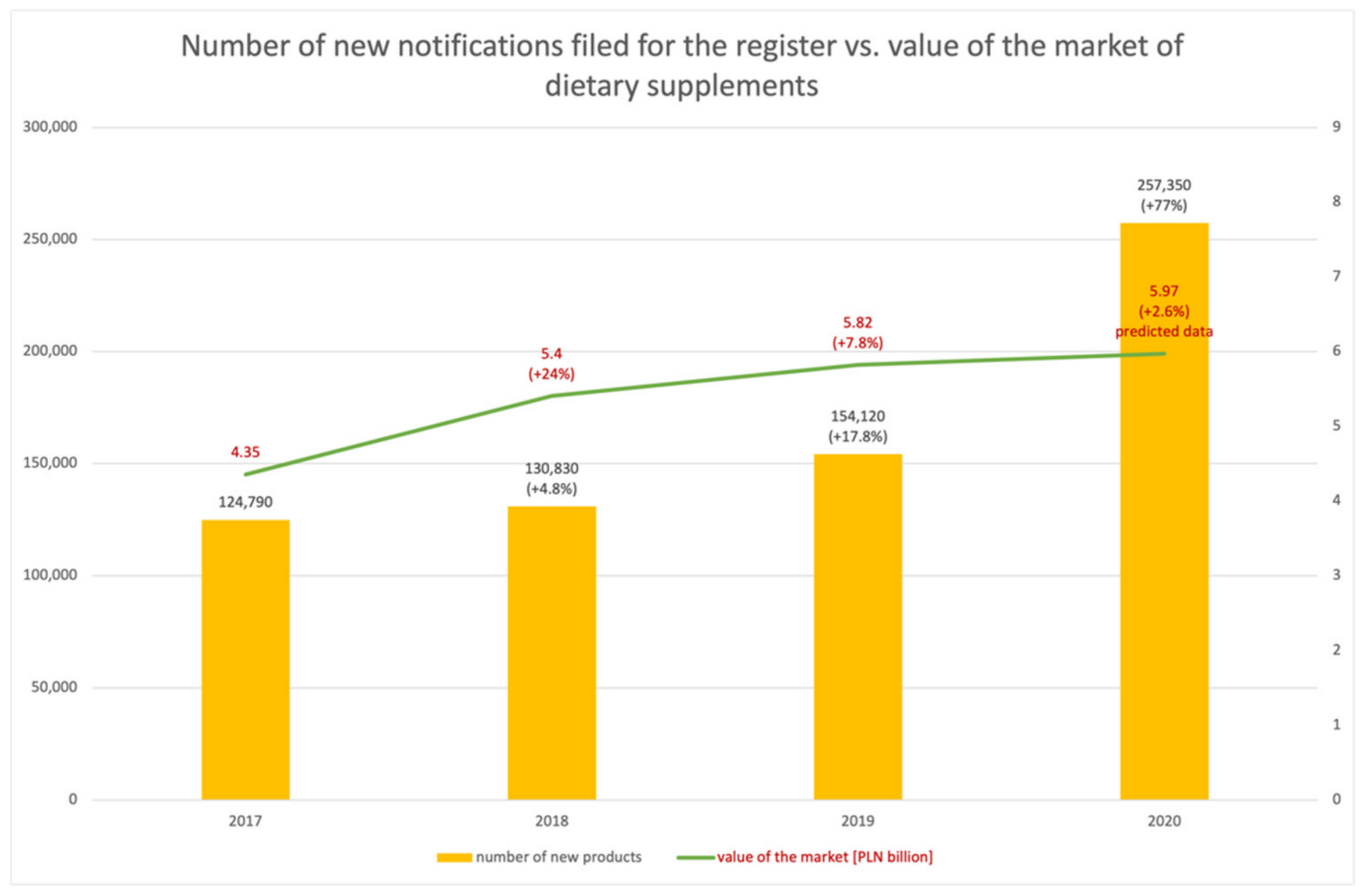

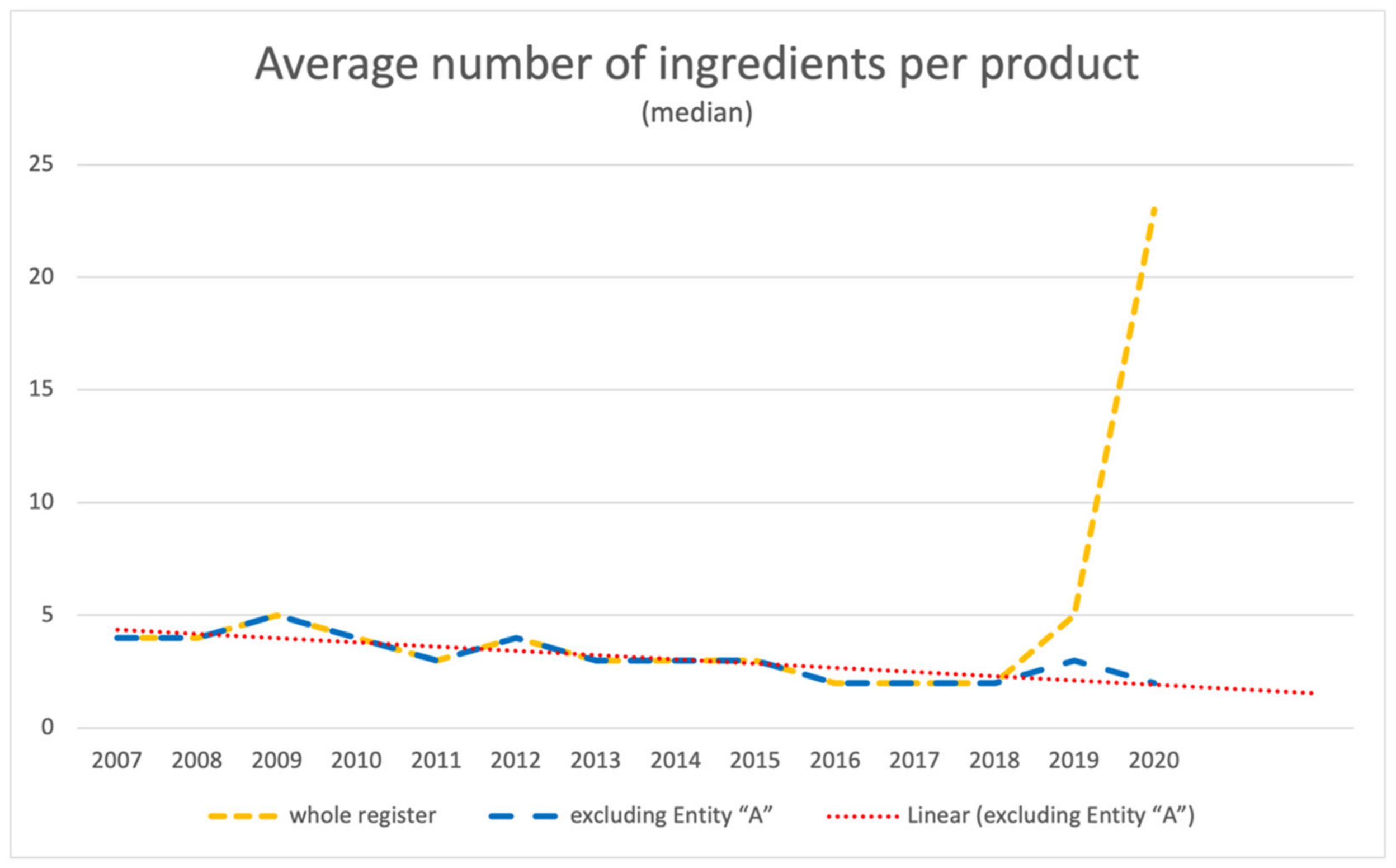
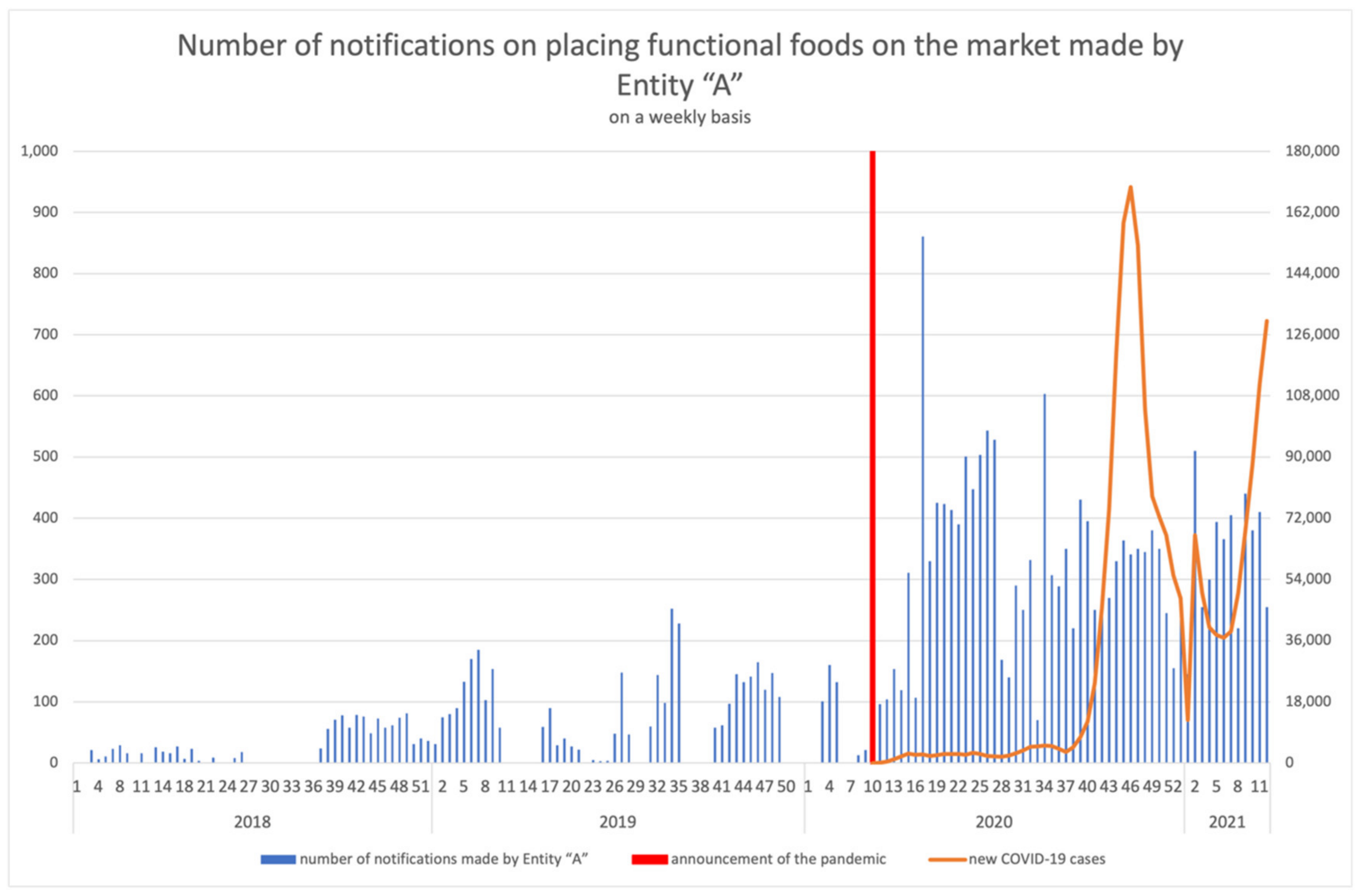
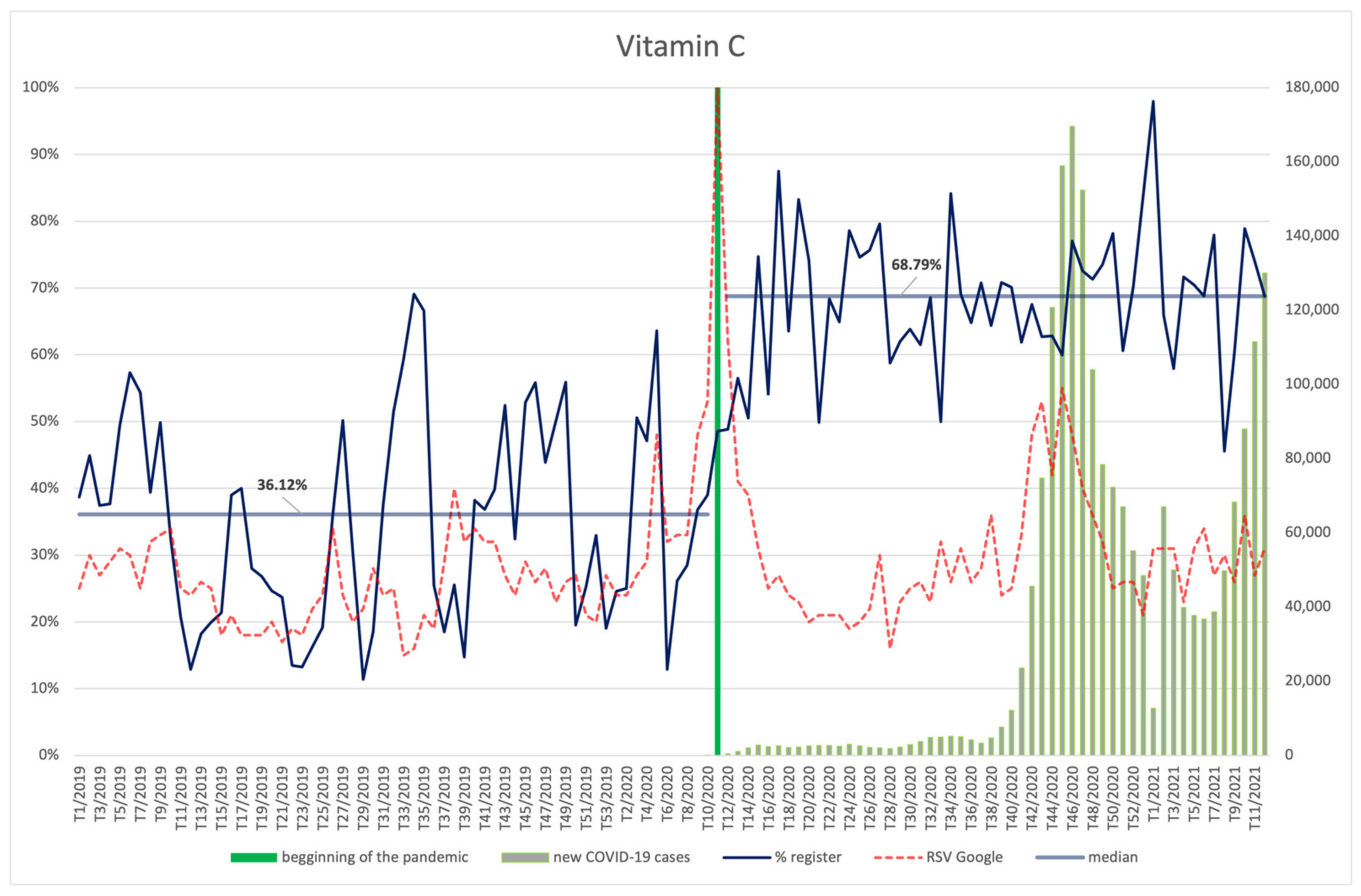

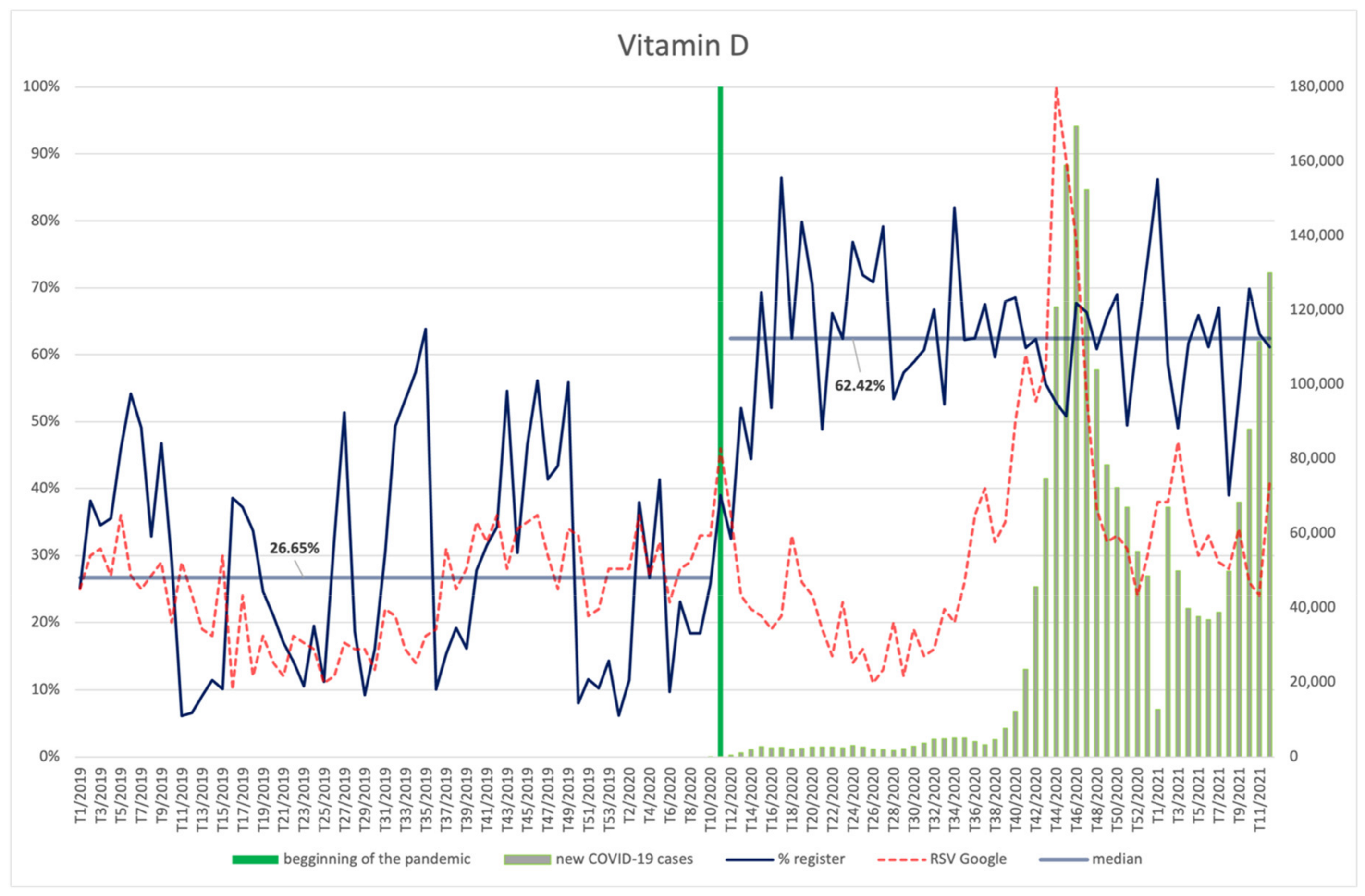

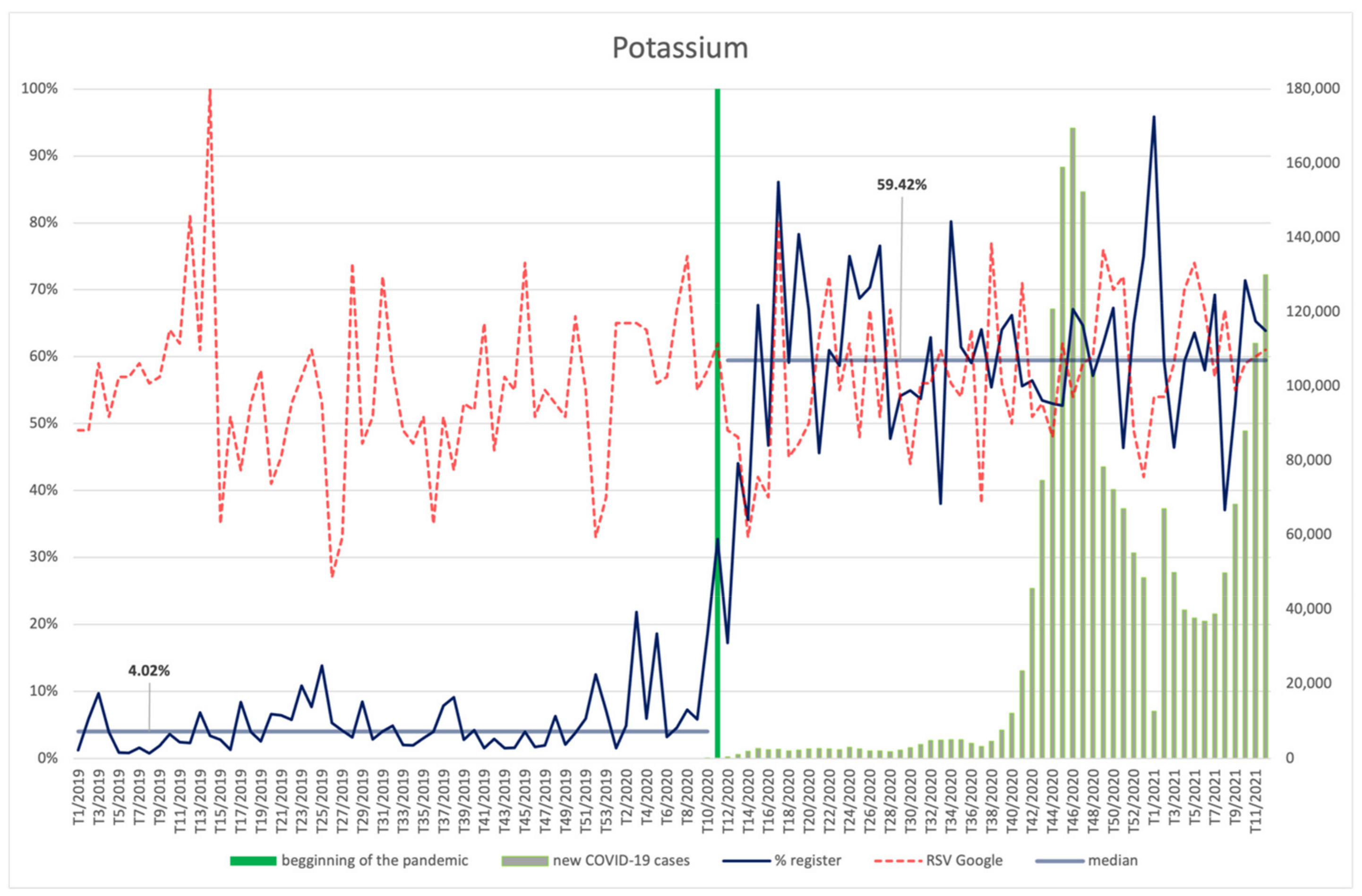
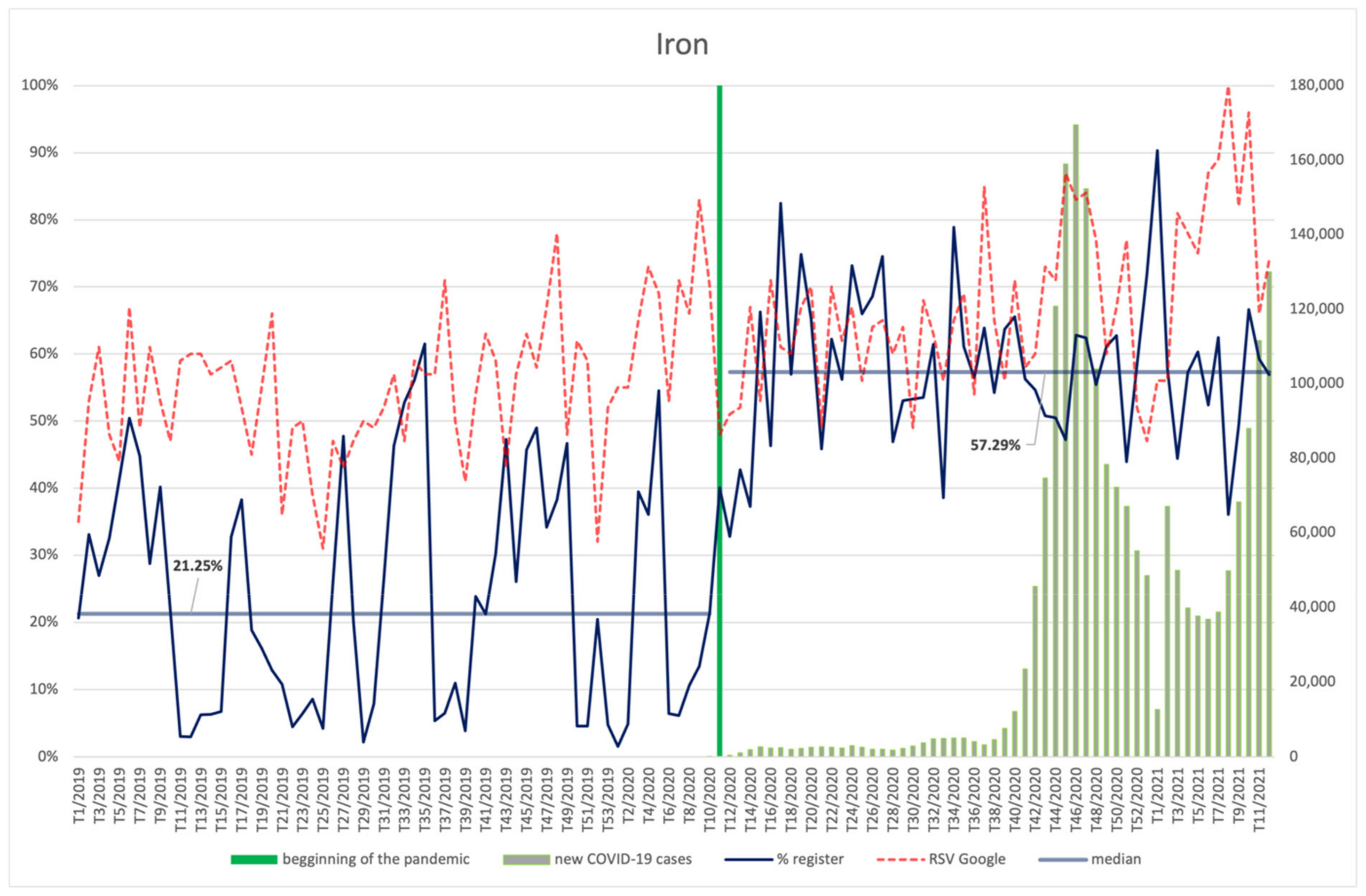
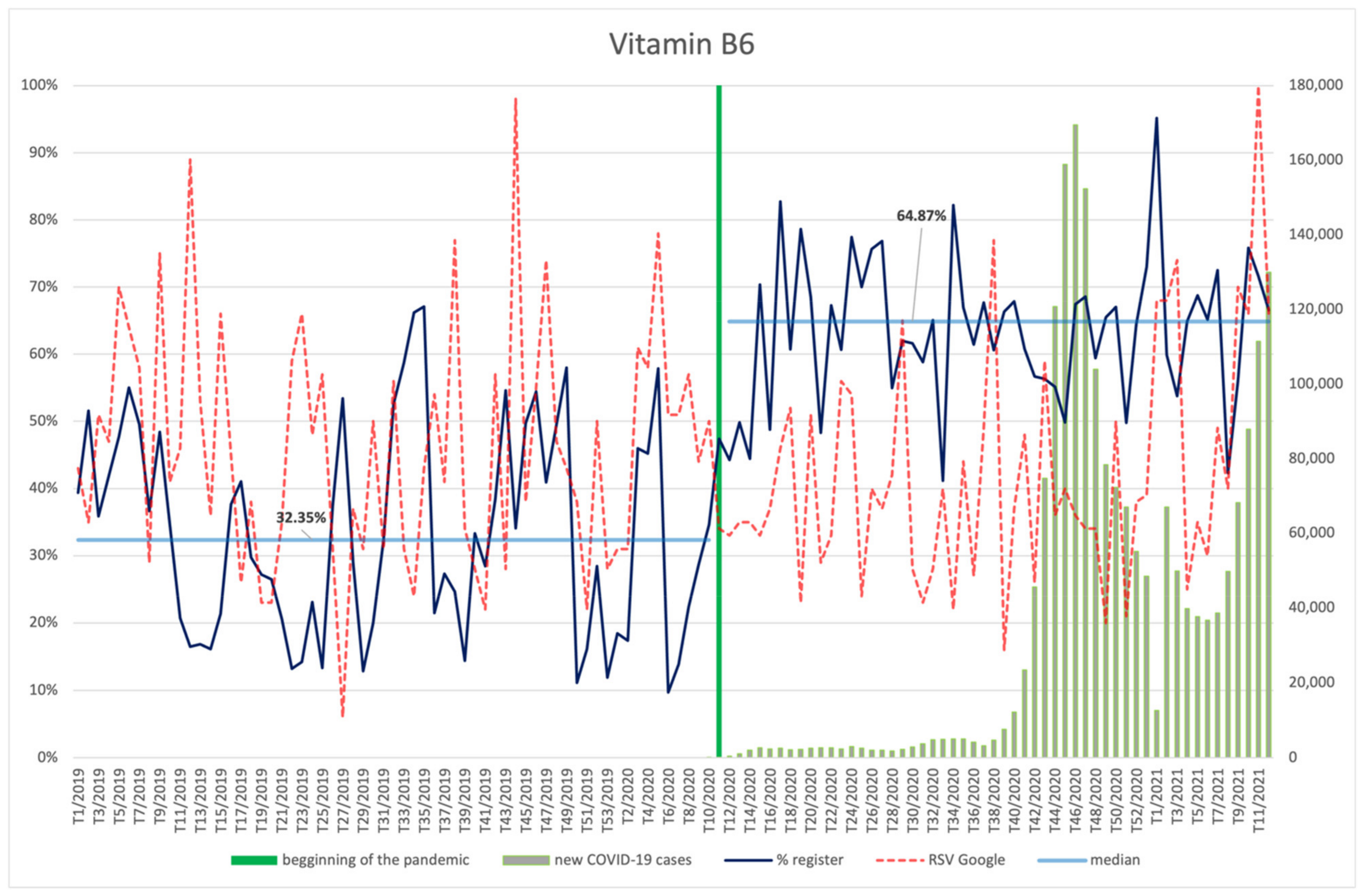
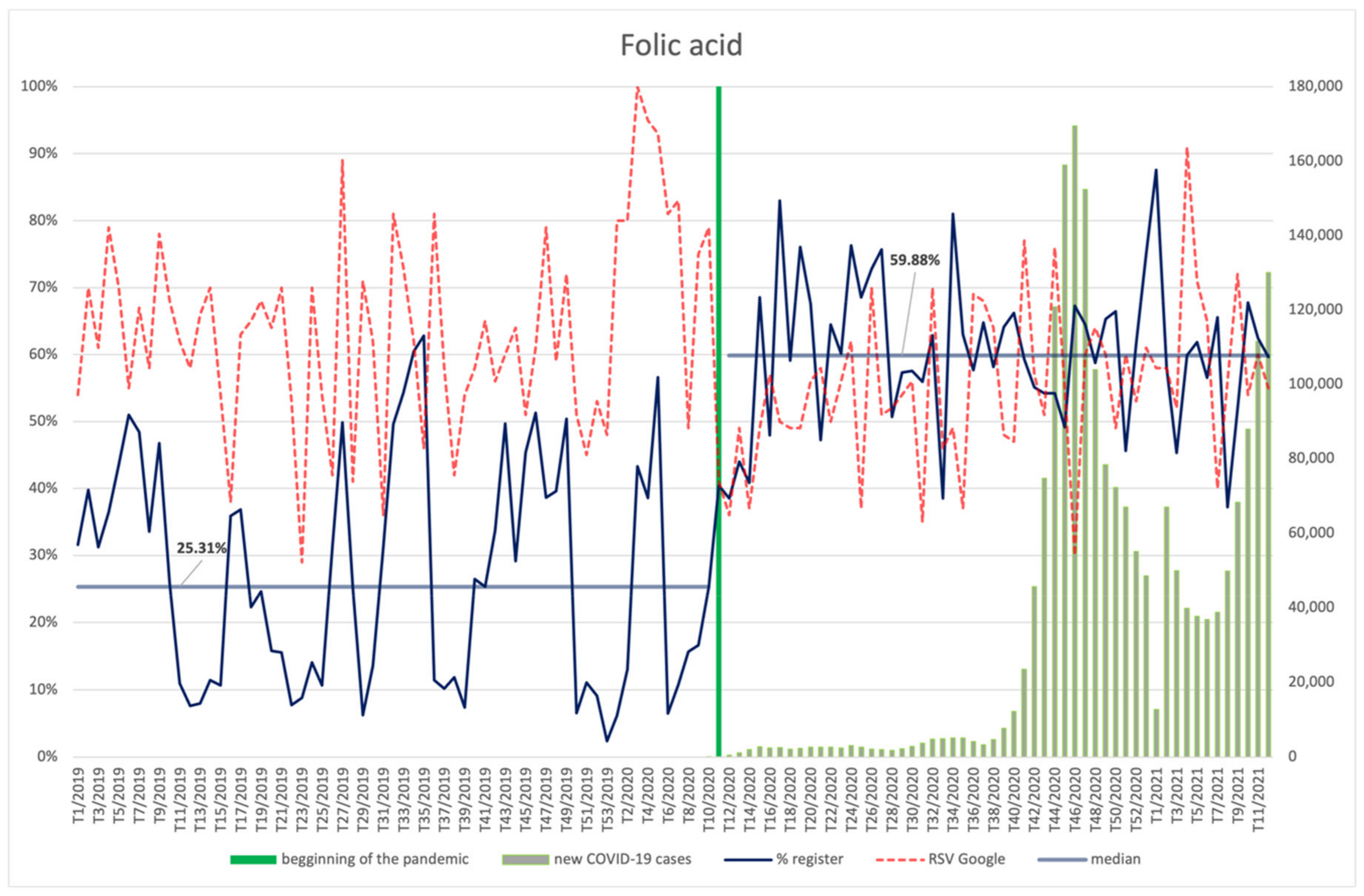
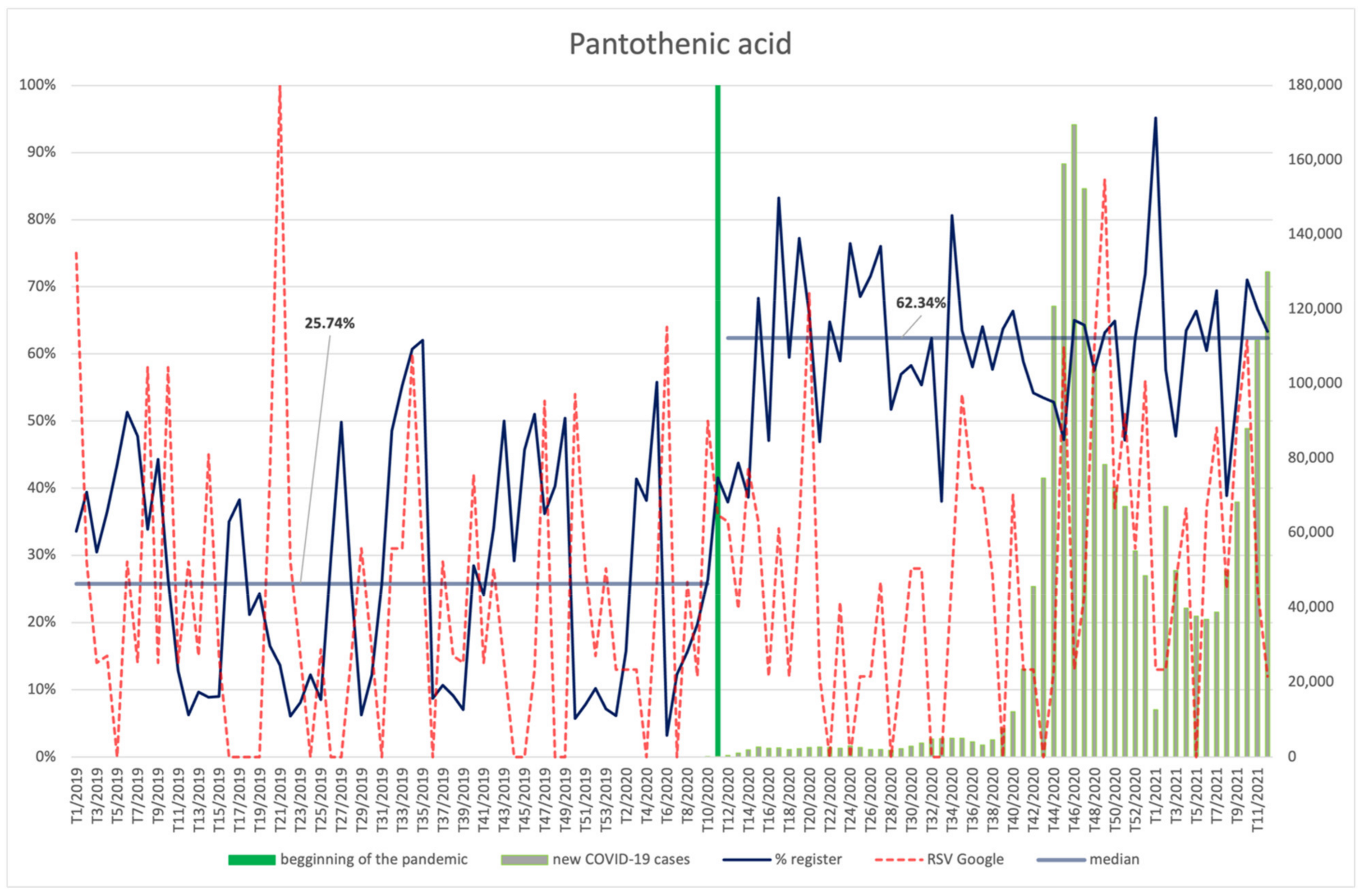
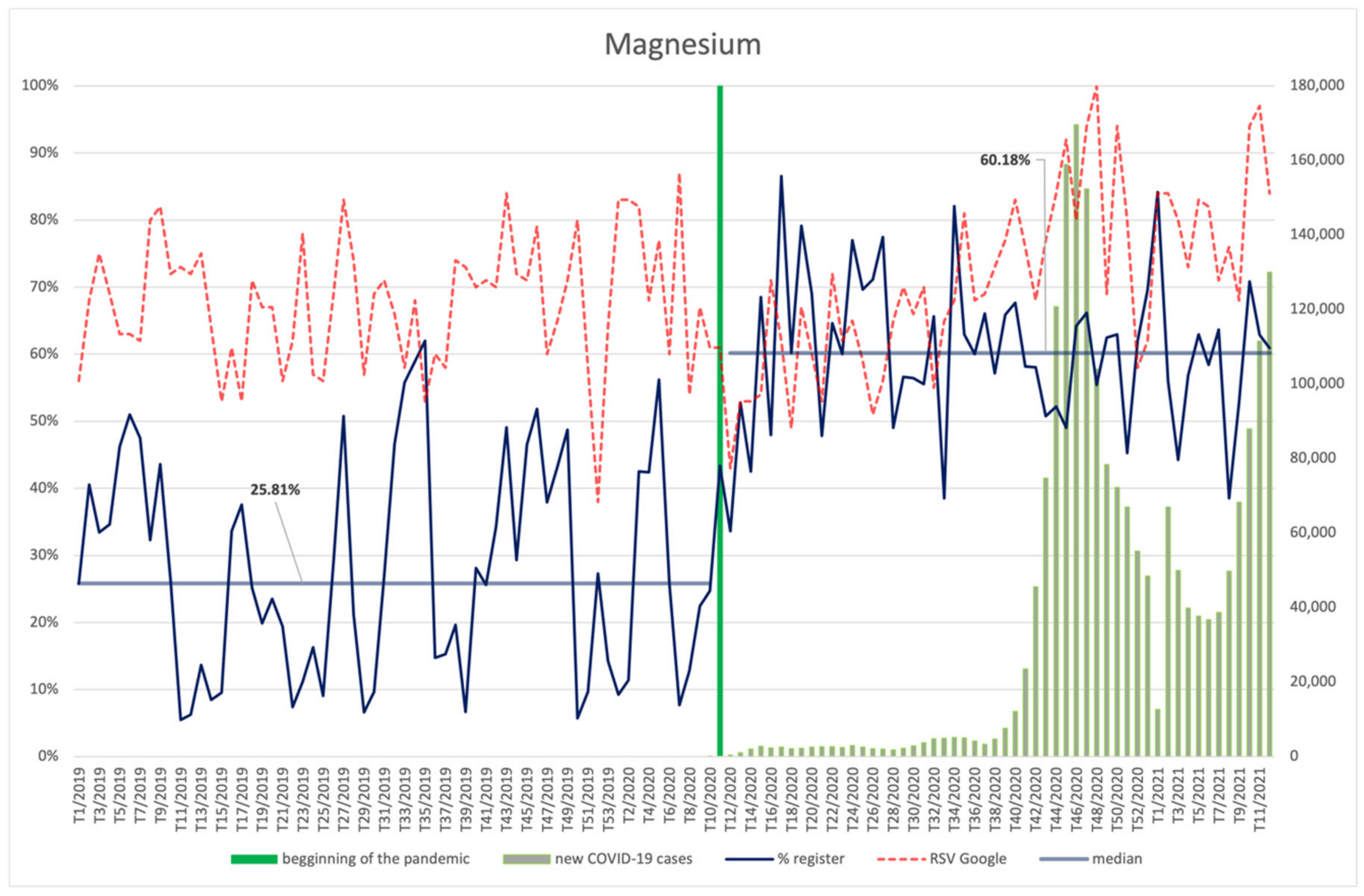
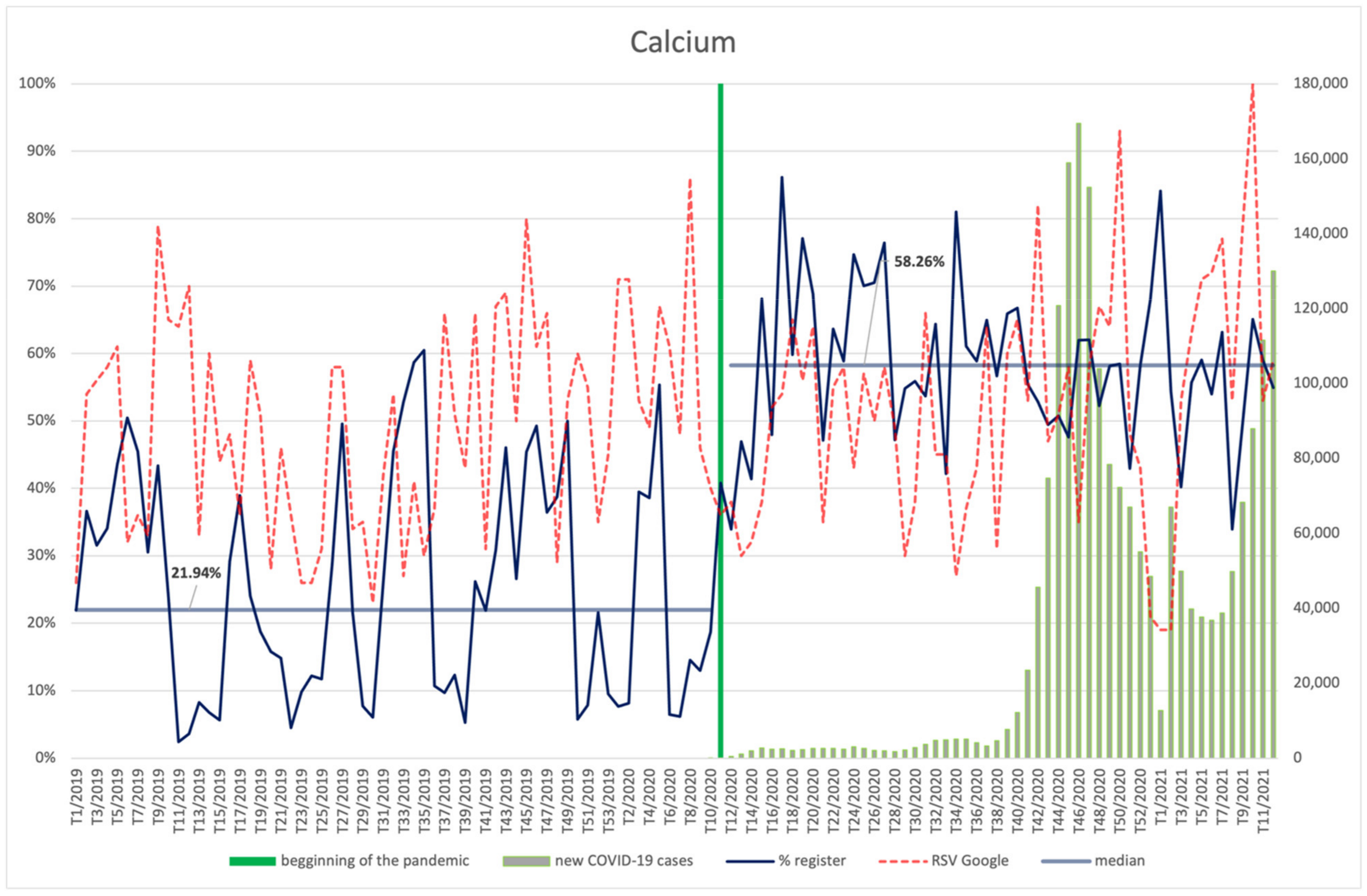
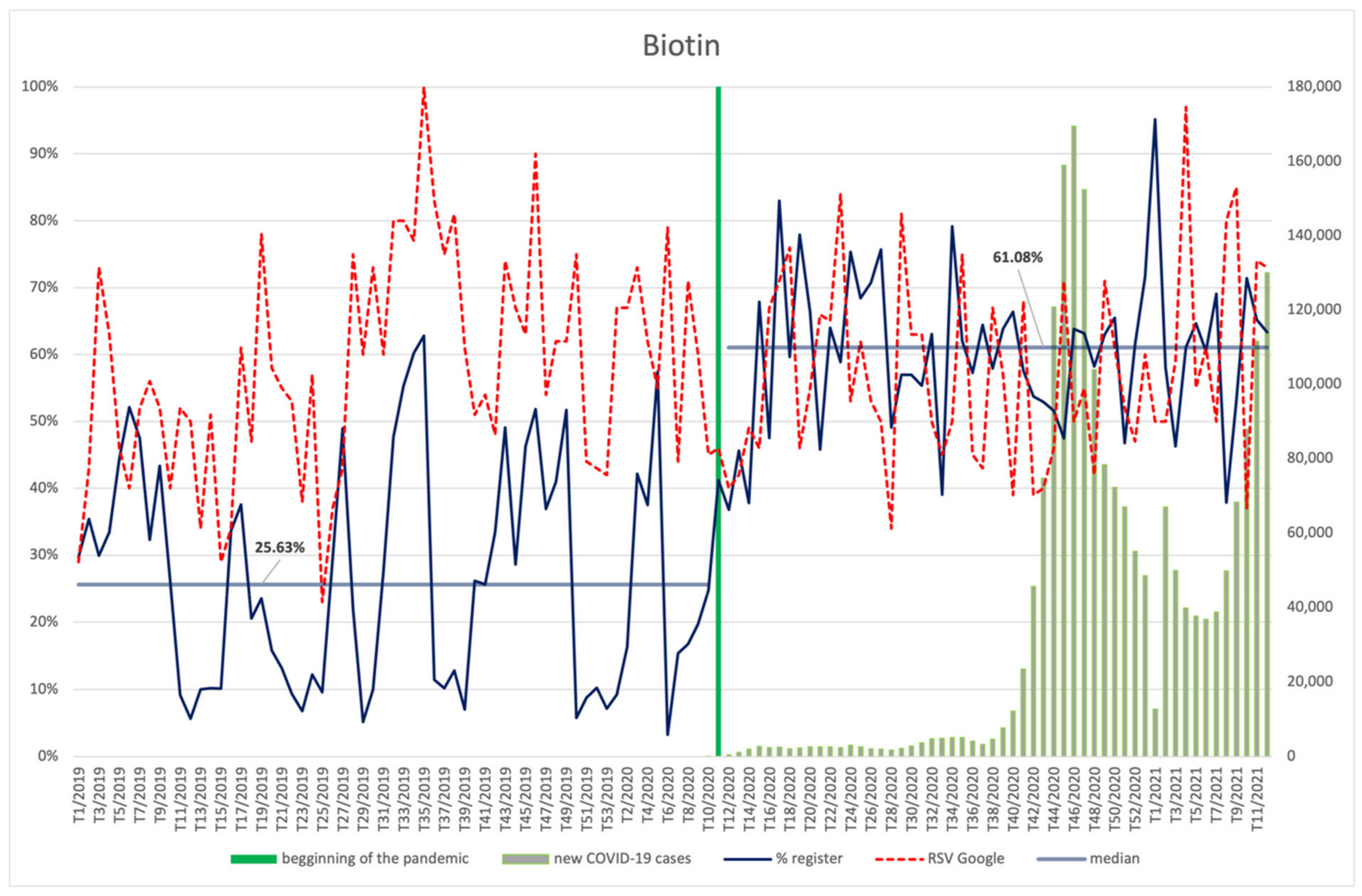
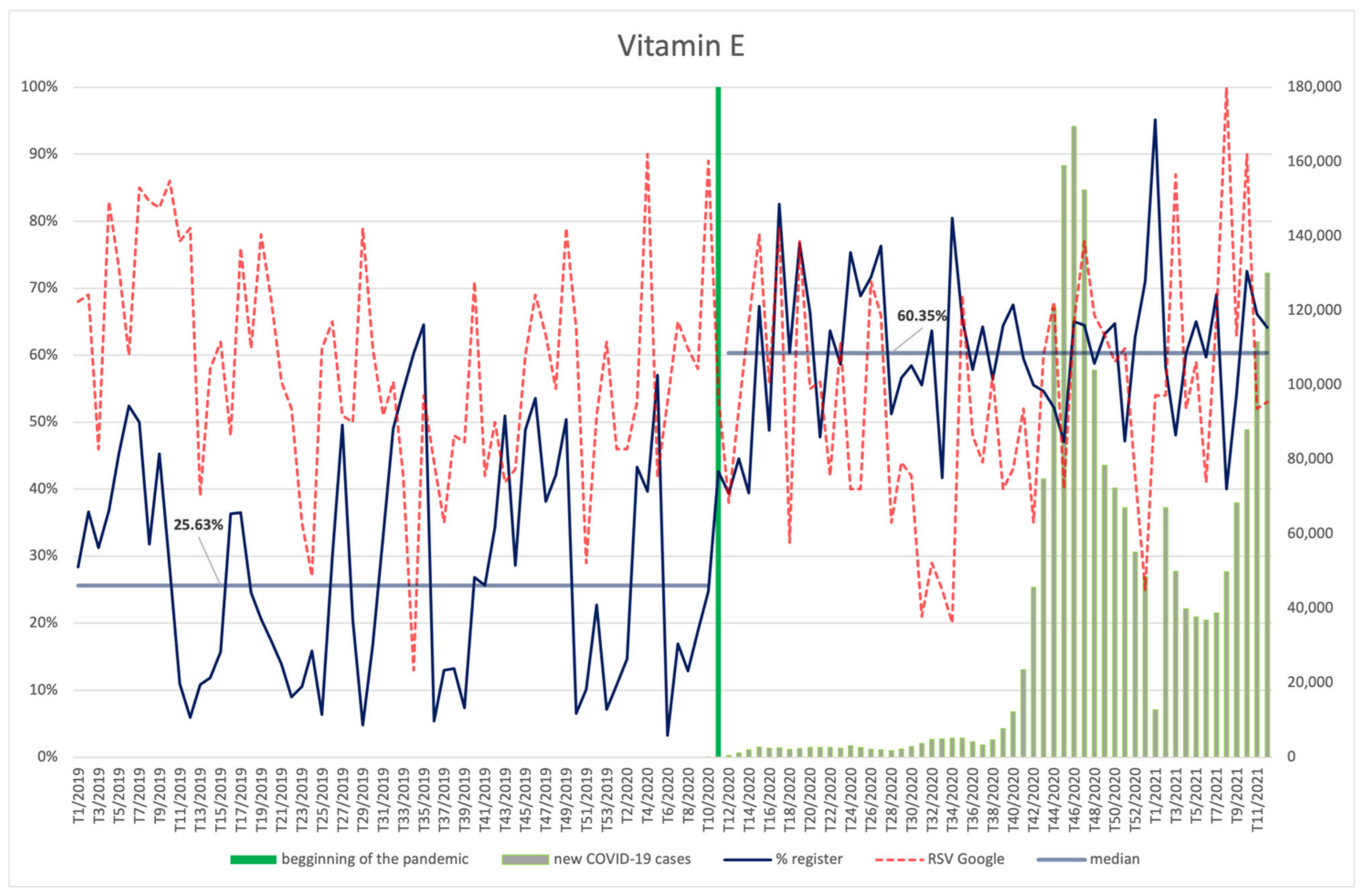
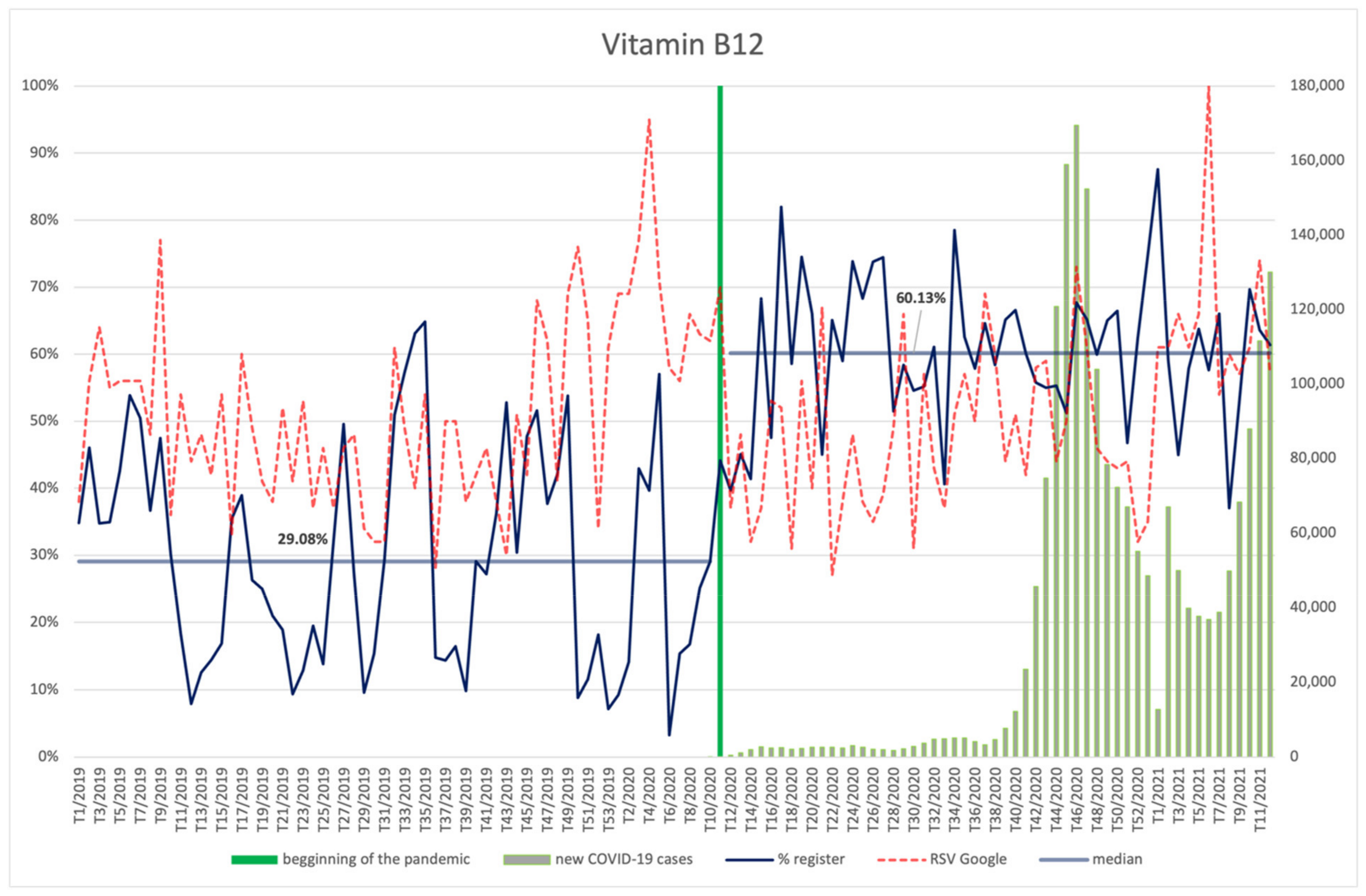

| Year/Number of Notifications | Entity A | Entity B | Entity C | Entity D | Entity E | Entity F | Entity G | Entity H | Entity I | Entity J |
|---|---|---|---|---|---|---|---|---|---|---|
| 2017 | 1285 | 51 | 127 | 362 | 74 | |||||
| 2018 | 1229 | 186 | 1722 (↑ 134%) | 62 (↑ 122%) | 62 (↓ 51%) | 428 (↑ 118%) | 77 (↑ 104%) | |||
| 2019 | 3558 (↑ 290%) | 11 (↓ 94%) | 730 (↓ 58%) | 7 | 136 (↑ 219%) | 63 (↑ 102%) | 345 (↓ 19%) | 68 (↓ 12%) | ||
| 2020 | 14448 (↑ 406%) | 606 (↑ 5509%) | 554 (↓ 24%) | 325 | 314(↑ 4486%) | 308 (↑ 226%) | 154 (↑ 143%) | 148 (↓ 57%) | 131 (↑ 193%) | 123 |
| 2021 | 4080 | 153 | 160 | 7 | 34 | 3 | 12 | 35 | 28 |
Publisher’s Note: MDPI stays neutral with regard to jurisdictional claims in published maps and institutional affiliations. |
© 2021 by the authors. Licensee MDPI, Basel, Switzerland. This article is an open access article distributed under the terms and conditions of the Creative Commons Attribution (CC BY) license (https://creativecommons.org/licenses/by/4.0/).
Share and Cite
Wróbel, K.; Milewska, A.J.; Marczak, M.; Kozłowski, R. The Impact of the COVID-19 Pandemic on the Composition of Dietary Supplements and Functional Foods Notified in Poland. Int. J. Environ. Res. Public Health 2021, 18, 11751. https://doi.org/10.3390/ijerph182211751
Wróbel K, Milewska AJ, Marczak M, Kozłowski R. The Impact of the COVID-19 Pandemic on the Composition of Dietary Supplements and Functional Foods Notified in Poland. International Journal of Environmental Research and Public Health. 2021; 18(22):11751. https://doi.org/10.3390/ijerph182211751
Chicago/Turabian StyleWróbel, Kacper, Anna Justyna Milewska, Michał Marczak, and Remigiusz Kozłowski. 2021. "The Impact of the COVID-19 Pandemic on the Composition of Dietary Supplements and Functional Foods Notified in Poland" International Journal of Environmental Research and Public Health 18, no. 22: 11751. https://doi.org/10.3390/ijerph182211751
APA StyleWróbel, K., Milewska, A. J., Marczak, M., & Kozłowski, R. (2021). The Impact of the COVID-19 Pandemic on the Composition of Dietary Supplements and Functional Foods Notified in Poland. International Journal of Environmental Research and Public Health, 18(22), 11751. https://doi.org/10.3390/ijerph182211751







